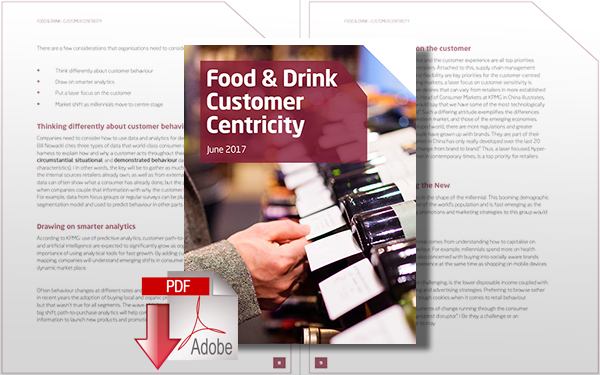Six Must Have Supply Chain Capabilities for Success in the Food and Beverage Industry

The food & beverage industry faces a lengthy list of unique challenges from long raw material lead-times and volatile commodity pricing to safety and quality requirements combined with high demand uncertainty, frequent new product introductions, perishability and complex manufacturing constraints.
To succeed in today’s hyper-competitive market, F&B companies must build a strong foundation of flexible supply chain processes, run by knowledgeable and experienced people and enabled by integrated and agile systems.
Consensus Demand Planning
Most companies recognize the importance of a repeatable and accurate forecasting process. Accurate forecasts help minimize inventory, maximize production efficiency, streamline purchasing, optimize distribution and ensure confidence in company projections.
However, developing a demand plan that people in different areas and roles can use to build individual operating plans can be very challenging. There needs to be a “business forecast champion” who understands the value of a consensus demand plan—someone who has the organizational influence to lead process improvement, motivate people and identify new technology-enabling opportunities.
The demand planning team itself must include members who feel comfortable with statistics and data analysis, and can collaborate and negotiate with other business functions to drive to a consensus plan. Additionally, the champion and team need the right technology that enables the development of baseline forecasts and facilitates collaboration across all functional teams.
Advanced Inventory Management
Inventory is one of the most visible supply chain expenses and is a line on the Balance Sheet under current assets. The amount of inventory required is a byproduct of customer service levels, supply chain design, product quality and a company’s ability to predict demand and produce product in a timely manner.
Basic inventory policies that do not consider the unique demand variability, customer service targets, lead-time and lead-time variability of each product/location combination will result in misaligned inventory positions.
An advanced inventory planning solution provides the power to automatically determine the proper inventory control parameters for each SKU/location combination leading to improved customer service at overall lower inventory levels.
Optimal inventory control parameters can then be uploaded to a company’s manufacturing, purchasing and distribution solutions to ensure the right raw materials are purchased at the right time, the right products are produced at the right time, and the right products are moved to the right distribution location at the right time to meet customer requirements.
Time-Phased Replenishment Planning
Using the outputs from demand and inventory planning, replenishment planning provides future visibility of customer demands, product and material requirements, and the actions needed by suppliers and manufacturing to efficiently satisfy market demand.
F&B manufacturers are increasingly being asked to manage inventory at customer locations or guarantee a rapid replenishment cycle.
Advanced replenishment planning can help develop a cost-effective supply chain strategy that ensures customer service levels remain high while minimizing costs. To resolve potential problems in advance, replenishment planning lets you accurately project demand, supply and inventory levels into the future to create a realistic picture of product and material requirements.
You can easily consider the effects of inventory investment, service levels and current orders and commitments. Leveraging Distribution Resource Planning (DRP), you can gain multi-level insights into demand and inventory.
You can view inventory from multiple perspectives: actual demand data, future distribution needs and replenishment commitments. Advanced probabilistic safety stock methods minimize inventory investments and create time-phased replenishment orders for each item.
Demand-Driven Manufacturing Planning
In some food and beverage companies, manufacturing facilities operate somewhat independently from the rest of the supply chain. F&B manufacturing plants tend to be very capital intensive and often the top goal is to maximize the output for these expensive resources.
Unfortunately, focusing too much on manufacturing efficiency can lead to large batch sizes that are often misaligned with actual customer demand. A better approach is to focus on minimizing the end-to-end supply chain costs required to meet customer demand.
Less efficient operations in one area of the supply chain can lead to greater efficiencies in other areas, providing a lower overall supply chain cost.
Manufacturing planning uses the output from demand, inventory and replenishment planning to determine how much of what products to produce to minimize cost while meeting customer requirements.
Manufacturing planning helps develop capacity plans and detailed schedules that respect manufacturing constraints, optimize changeovers and lower inventory of finished goods and raw materials.
Supply Chain Master Data Management
As the F&B industry continues to increase in speed and complexity, you may find that your enterprise resource planning (ERP) and related enterprise business solutions do not provide the breadth and depth of data capabilities needed to support advanced supply chain planning and optimization.
The continued adoption of more mature business processes plus the ability to leverage the Internet-of-Things (IoT), further drives the need to connect multiple enterprise systems across your organization.
A supply chain system master data management solution can ensure robust, high quality data, including data that originates from external sources, is available to drive supply chain planning and execution operations.
Sales and Operations Planning (S&OP)
Whereas manufacturing planning helps a company balance supply and demand in the shorter term, sales and operations planning focuses on aligning and balancing supply and demand over the tactical time horizon while ensuring company financial objectives are met.
Sales and operations planning can transform diverse information from sales, production, finance, marketing, transportation and procurement into one powerful central resource for analysis and decision making.
With a comprehensive S&OP process in place, you can cut days or weeks from your planning process, streamline the planning cycle and complete multi-divisional analysis in a fraction of the time.
S&OP best practices let you compare multiple “what-if” scenarios, evaluate critical decisions and prepare contingency strategies to avoid risk and pre-empt your competition when market situations change.
Much has changed in the Food & Beverage Industry over the last 20 years. However, F&B companies still need to have a strong foundation of supply chain capabilities to ensure success. The six must have supply chain capabilities listed above lay the foundation for more advanced supply chain capabilities.
Food & Drink - Customer Centricity
In recent years, product variety in the food & drink industry has exploded and competition has become intense.

This white paper highlights the challenges the food and drink industry faces and the need to evolve to a changing customer and evolving marketing conditions.
Article Topics
Logility News & Resources
Logility makes entrance into supply chain-focused AI, with acquisition of Garvis Logility Acquires Generative AI Supply Chain Planning Firm Garvis Supply chain software platforms help to level the playing field Logility to acquire supply chain network optimization vendor Starboard Solutions Logility partners with Körber to expand capabilities How Does IKEA’s Inventory Management Supply Chain Strategy Really Work? This is Not Your Father’s Inventory Optimization More LogilityLatest in Supply Chain
Baltimore Bridge Collapse: Impact on Freight Navigating TIm Cook Says Apple Plans to Increase Investments in Vietnam Amazon Logistics’ Growth Shakes Up Shipping Industry in 2023 Spotlight Startup: Cart.com is Reimagining Logistics Walmart and Swisslog Expand Partnership with New Texas Facility Nissan Channels Tesla With Its Latest Manufacturing Process Taking Stock of Today’s Robotics Market and What the Future Holds More Supply Chain













